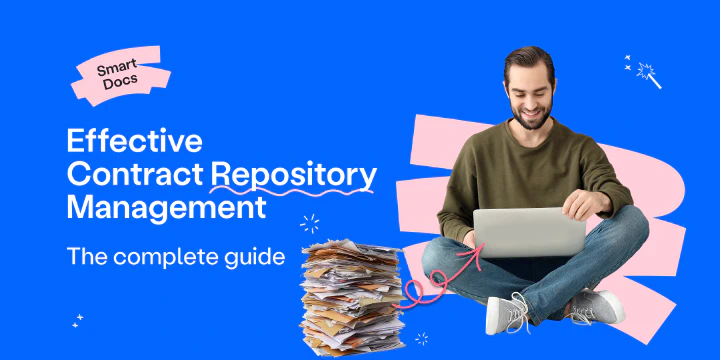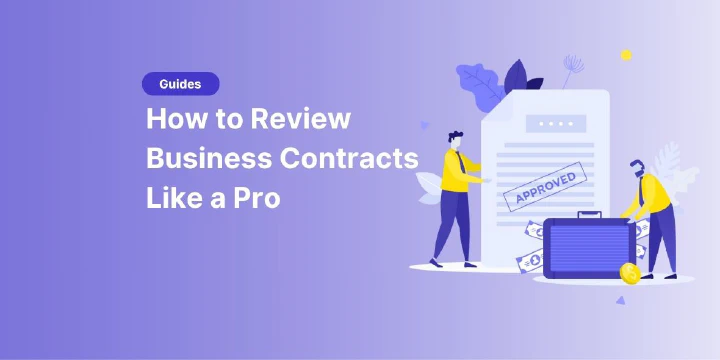Contract management: 4 steps to optimization
Proper contract management helps meet deadlines and increase productivity while reducing liability issues. Every company needs streamlined contract management - here’s how to successfully improve your contract management.

What is Contract Management?
Contract Management can be summarized as managing the creation, execution and administration of contracts. The goal is to simultaneously optimize business performance and reduce financial risk. In contract management, the entire lifecycle of contractual relationships is viewed as a business process. And as a business process, it can be measured, analyzed and improved. Effective contract management goes far beyond protecting a company from legal risk; it ensures that the contract process runs more efficiently and allows a company to operate more profitably.
The key features of contract management
To improve its contract management, it is first important to understand the key features and tasks of contract management:
- Service delivery: ensuring that products are delivered when they have been requested.
- Relationship management: improving the relationship between the contracting parties by consolidating contact between the relevant parties.
- Contract Management: Manage and monitor day-to-day contract processes and ensure they are in compliance with contractual agreements.
- Search for improvements in the contractual agreement: regularly modifying the contractual agreement to better adapt the contract to changes in the business environment, ensuring that the business model remains relevant and up-to-date between the parties concerned.
- Continuous evaluation: ensuring that activities are in compliance with relevant rules and regulations promotes quality of services
Why is it worth improving your contract management?
Contract management is typically a disjointed and widely branched process, usually done across numerous platforms such as spreadsheets, Google or Microsoft Word documents, emails, and paper. It can also lack transparency and collaboration as individual departments set up and manage their own contracts. Additionally, during this process, it is more difficult to access centralized analytics and information to improve contracting. Therefore, it is important to have well-defined contract management to address these challenges.
4 steps to improve the contract management process
If you’re wondering how to improve contract management, you first need to understand how it works. The contract management process includes how a contract comes into existence, how it is managed and executed, and whether or not it is renewed. This process needs to be analyzed and improved, the following 4 points show how this works:
1. review the current contract management process and set goals
There is a reason why you are currently thinking about improving your Contract Management process. Something is not working the way you would like it to right now. The first step to becoming more efficient is to review your current contract management process. Document the process in detail to find out what is working and what is not. This will give you an accurate view of how you can and should improve it.
With this knowledge in hand, you should now define specific, attainable objectives. Perhaps you need to achieve cost savings, reduce risk, or increase visibility. To successfully redesign your contract management, you need to be clear about why you want to change your current process and what you want to achieve.
2. use templates for contract management
Using contract templates with standardized wording is an effective way to enforce consistency and manage risk while saving time and money. In addition, contract templates provide a better understanding of contractual obligations and reduce the need for multiple negotiation cycles.
Using simplified language and less jargon makes your contract management templates more user-friendly for both your departments and your customers. Make sure to get the views and approvals of your legal, business, HR, and finance departments to get the best results from your templates.
3. automation of your contract management
Managing master agreements, service agreements, non-disclosure agreements, employment contracts, vendor contracts and other legal documents can become increasingly complex, especially as your business grows and the number of contracts increases. A chaotic, disorganized contract management process makes it difficult for you to keep track of critical deadlines and important compliance data.
You need a central location where you can manage all signed contracts throughout their lifecycle and easily store, retrieve and view them as needed. Automation is key. Investing in contract management software is a highly effective solution to your contract management challenges. It enables better organization, more streamlined processes, less wasted time, fewer administrative errors and duplications, higher productivity, more consistency, and lower costs and expenses. Using technology also increases visibility, making it easier for you to identify current and future contract risks and issues before they become serious problems. Get a 360-degree view of all your contracts, which would not be possible with a manual contract management process.
4. Create a plan to continuously review your contract management
Your company will evolve quickly - it needs to in order to stay ahead of the competition and solidify its place in the market. What works today in contract management could be outdated and ineffective in the near future. Put someone in charge of reviewing the process on a monthly, quarterly or annual basis. Highlight the successes you have achieved, discuss new challenges or risks that have surfaced, and make changes to your contract management as needed to continue to achieve the desired results.
Conclusion
Many companies fall behind their competitors because they have failed to recognize the importance and positive impact of well-organized contract management. When companies don’t make an effort to optimize their contract process, they waste time and resources that could be better spent elsewhere. This means that a cohesive and well-established contract management process is valuable to any business because it provides room for growth.
By following these steps to improve contract management, you’ll ensure that your company is handling its legal documents in the best way possible, saving time and money that you can use to grow your business. In short, if you want to move your business forward, you need to know how to manage contracts efficiently.
Please keep in mind that none of the content on our blog should be considered legal advice. We understand the complexities and nuances of legal matters, and as much as we strive to ensure our information is accurate and useful, it cannot replace the personalized advice of a qualified legal professional.

Table of contents
Want product news and updates? Sign up for our newsletter.
Other posts in Contract-Management

SaaS contract management explained for buyers and vendors
If you work in SaaS, you know how quickly contracts can pile up. Each one comes with its own terms, renewals, …

The Complete Guide to Effective Contract Repository Management
A contract repository is where every agreement your business depends on finally finds its place. No cluttered …

How to Review Business Contracts Like a Pro in 2025
When it comes to business contracts, what you don’t catch can hurt you. That’s why reviewing a business …
Contracts can be enjoyable. Get started with fynk today.
Companies using fynk's contract management software get work done faster than ever before. Ready to give valuable time back to your team?
Schedule demo

